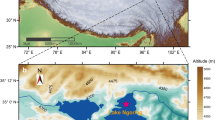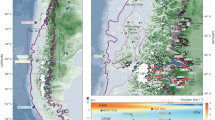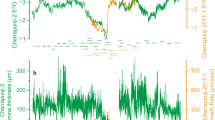Abstract
Pronounced climatic change during the last glacial maximum is recognized as global in extent, and has been attributed to orbital forcing1. Not readily explained in a global context because of the equivocal nature of the evidence are the late-glacial climatic events of short (100–1,000-yr) duration. The cold climate of the Younger Dryas chron (∼11,000–10,000 yr BP), for example, is known to have been particularly pronounced over the North Atlantic and parts of Europe and North America2,3, whereas in the Southern Hemisphere, cold conditions for that time are not well established. Here we present evidence for late-glacial climatic cooling in southernmost South America from studies of radiocarbon-dated glacial and pollen stratigraphy at sites along the Beagle Channel in Tierra del Fuego, where a forest–tundra tension zone in the region is especially sensitive to shifting climate. We conclude that the cold episode corresponds with the time of the Younger Dryas in Europe, when a drop in temperature, ascribed most recently to colder sea surface temperatures and production rate of deep water in the North Atlantic4,5, apparently occurred worldwide.
This is a preview of subscription content, access via your institution
Access options
Subscribe to this journal
Receive 51 print issues and online access
$199.00 per year
only $3.90 per issue
Buy this article
- Purchase on Springer Link
- Instant access to full article PDF
Prices may be subject to local taxes which are calculated during checkout
Similar content being viewed by others
Author information
Authors and Affiliations
Rights and permissions
About this article
Cite this article
Heusser, C., Rabassa, J. Cold climatic episode of Younger Dryas age in Tierra del Fuego. Nature 328, 609–611 (1987). https://doi.org/10.1038/328609a0
Received:
Accepted:
Issue Date:
DOI: https://doi.org/10.1038/328609a0
This article is cited by
-
Late Pleistocene and Holocene palaeoenvironmental changes in central Tierra del Fuego (~54°S) inferred from pollen analysis
Vegetation History and Archaeobotany (2016)
-
Timing of the late glacial and Younger Dryas cold reversal in southern Chile varved sediments
Journal of Paleolimnology (2008)
-
Exceptionally steep north–south gradients in lake temperatures during the last deglaciation
Nature (1997)
-
High-frequency climatic oscillations during the last deglaciation as revealed by oxygen-isotope records of benthic organisms (Ammersee, southern Germany)
Journal of Paleolimnology (1994)
-
Oxygen isotope records of benthic ostracods in bavarian lake sediments
Naturwissenschaften (1992)
Comments
By submitting a comment you agree to abide by our Terms and Community Guidelines. If you find something abusive or that does not comply with our terms or guidelines please flag it as inappropriate.



